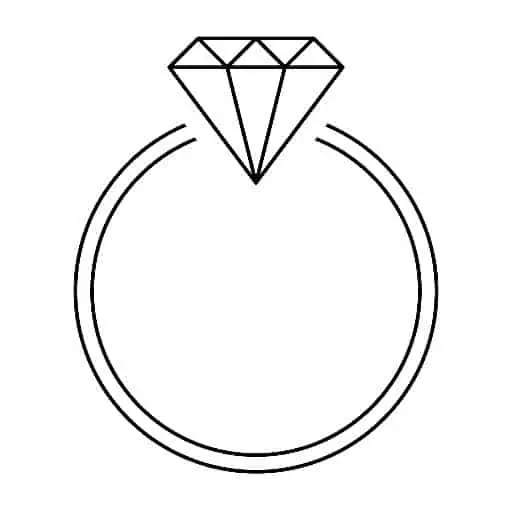Technology in the lab grown diamond field is improving fast! New milestones are being reached for the size and quality of diamonds grown in laboratories that dot the globe—almost constantly!
Just how big can Lab Grown Diamonds get? Current technology and processes can produce jewelry quality diamonds, with excellent color and clarity, that are up to about 10 carats in weight. Growing much larger diamonds, will likely require significantly redesigned equipment. Industrial grade diamonds can be grown in excess of 150 carats.
Different manufacturing processes have unique challenges barriers to creating later gem quality diamonds. We’ll highlight those issues below.
Why Large Diamonds are Grown in Labs?
How big does the diamond on your finger really need to be? I saw a 9 carat diamond the other day, and it honestly looked a little over-the-top. It was a beautiful stone, and I could appreciate it for that, but do we need, or want, a diamond that’s 20 carats, 50 carats, 100 carats, or 200 carats for jewelry purposes? At some point, you can no longer lift your hand because your diamond is so cartoonishly large and heavy, that it’s not longer practical.
So if diamonds rarely need to be larger than 9 carats for jewelry application, why are manufacturers still trying so hard to push the boundaries of what’s possible regarding size (while still delivering quality)? There are several reasons that there seems to be a race between various manufacturers to set know records for the size of high-quality gem-grade diamonds.
- Publicity and bragging rights
- Advancement of the product and the industry
- For use in industrial applications
Publicity is important. Exciting news about significant advancements can be reported on the news, in newspapers, magazines, and across the web. That helps spread awareness about the industry, which is valuable and important.
Publicity also creates specific brand awareness. The lab grown diamond industry has a lot more competitors than it did 10 years ago. Some of those competitors are here in the US, others are scattered around the globe.
Industrial demand for diamonds is diverse, but an extremely common application, is the tipping of drill bits and saw blades. Diamond is the hardest naturally occurring material known to man, so it cuts through normally hard and difficult materials that other metals and materials just can’t
The Largest Lab Diamonds Ever Made
There are two main processes that are commonly used to manufacture diamonds.:
HPHT (High Pressure High Temperature):
This process mimics the forces of the earth, applying intense heat and pressure to create a diamond in just 6 to 10 weeks. This is the oldest, and most widely adopted, technology used to manufacture diamonds. It requires a lot of power to achieve, and maintain, the heat and pressure needs of the process.
In 2015, a Hong Kong lab grown diamond manufacturer announced that they had created a diamond that was impressive for both size and quality. It was a record 10.02 carat HPHT diamond that was graded as having coloring of ‘E’ and clarity of VS1.
CVD (Carbon Vapor Deposition):
This approach is quite different. It utilizes low pressure, not high pressure. Diamonds are formed in a vacuum chamber. Carbon-rich gasses are continually fed into the chamber. Heat or microwaves are then used to cause the carbon to separate and fall on a diamond seed that’s on the substrate below. The diamond grows slowly with each particle that falls and bonds to the growing seed.
In 2018, WD Lab Grown Diamonds, out of Maryland, raised the bar in the industry by a wide margin. They announced that they had produced a CVD diamond that weighed in at a whopping 9.04 carats. Here again, it wasn’t a situation where they compromised on quality to achieve quantity—the record setting CVD diamond touts an I color grade, VS2 clarity, and an Ideal cut!
The Best Process for Growing Large Diamonds
For a long time, HPHT was far ahead of CVD in terms of the bounds of achievement. The HPHT process, for example, was capable of producing much larger gem quality diamonds. Over the past few years, however, CVD has made great progress in closing that gap. Over approximately the last year, the size of the largest CVD diamond grew by approximately 50% (from 6 carats to just over 9 carats).
While the HPHT process has still produced the largest jewelry grade diamond to date (at a little more than 10 carats), it’s difficult to say that they have a significant edge over CVD when it comes to the size of diamond that each process is capable of producing. I recent trends continue, it’s believable that a 10+ carat CVD diamond could be produced by a lab in the not too distant future.
There are limitations to our current technology that just mean that our processes and machinery will need to be adapted before we can grow jewelry grade diamonds in laboratories that are much larger than our current achievements.
The HPHT process applies incredible pressure to a diamond as it grows. That pressure is carefully controlled. It’s a critical part of the growing process. The presses used during the growing process aren’t able to focus the same amount of intense pressure to an object of any random size.
Imagine squeezing a marble between your thumb and index finger. You can bear down on the marble pretty hard. Now, imagine that someone switched the marble out for a golf ball. Does that change the pressure that you could squeeze that object with, using the same two fingers? Now, imagine that the swapped the golf ball for a pool table ball, and later with a basketball. Your ability to apply the same kind of intense pressure would change as object size changes.
The CVD process has an entirely different set of challenges. Since it grows diamonds in an ultra low-pressure environment, the main challenge becomes control of growth pattern. Instead of building in a structured way that would maximize the usable size of the diamond being grown, the CVD process can see crystal formation shooting off in a new random direction. The risk is particularly high when forming an exceptionally large diamond.
Keep in mind, that what we’re talking about here is production of gem quality diamonds. CVD technology is already capable of growing much larger diamonds for industrial application. At the moment though, there’s a tradeoff of quality when you go for too much quantity. Real progress is being made when we can achieve quantity without sacrificing quality (color, clarity, and the ability to achieve excellent cut).
How Costs are Impacted as Diamonds Grow Larger
Both the speed and cost of diamond growth aren’t linear and consistent. Diamonds tend to grow more slowly as they get larger. Diamonds up to about 1.5 carats are pretty standard for today’s labs. When they go much beyond that mark, the growth process can slow, and it also becomes more expensive.
Even with the added cost and difficulty, however, large gem quality diamonds represent large savings for those in the market to buy them. In 2016, for example, one manufacturer in the US produced a 6.28 carat Cushion Cut diamond that had a color grade of ‘J’ and clarity of VS2. It’s estimated, that an earth-mined diamond of similar size and quality would cost roughly $100,000. The manufacturer had plans to price their lab grown gem at $52,000, a savings of approximately 50%.
The Pace of Change is Accelerating
Synthetic diamonds have been pursued since the 1940’s. The unique properties of diamond have significant application and value in industry. Their hardness can be used to assist with drilling and cutting. It can also make a effective abrasive agent. They have high electrical resistance and excellent optical transparency that makes them useful in a wide range of mechanical applications.
The multi-national power house, General Electric, uses industrial diamonds in variety of ways many of the businesses they operate. A less expensive lab created diamond would really benefit their business, so in the early 1950’s, they continued the work of past contributors, and were soon making real progress. It was 1955 when then they told the world about their first synthetic diamond. It wasn’t something ready for wedding rings yet, but it could meet industrial needs.
It turned out to be more than 40 years before technology and learning progressed to the point that men were able to make diamonds were really suitable for jewelry applications. It took roughly 30 more years for the color, clarity, and carat weight capabilities of technology to start to really catch up earth mined diamonds, in a way that makes the two visibly indistinguishable, and on par regarding all points of quality and durability.
Around 2008, just as technology was starting to get really good with lab diamonds, Ulrich Boser, a writer, became interested in developments with lab-grown diamonds. He recorded the following experience in an article he wrote for Smithsonian magazine. It really captures the incredible nature of what has been achieved with man made diamonds.
He borrowed a .38 carat man made diamond with a princess-cut, and took it to a trusted contact in a downtown Boston jewelry store. Ulrich was interested to see if the lab grown diamond quality was really as good as some people believed it to be. In his article, he records the experiences and verbal exchange. He said,
“With a pair of tweezers, he brings the diamond up to his right eye and studies it with a jeweler’s loupe, slowly turning the gem in the mote-filled afternoon sun. ‘Nice stone, excellent color. I don’t see any imperfections,’ he says. ‘Where did you get it?’
‘It was grown in a lab about 20 miles from here,’ I reply.
He lowers the loupe and looks at me for a moment. Then he studies the stone again, pursing his brow. He sighs. ‘There’s no way to tell that it’s lab-created.”
Over the past decade, our manufacturing capabilities have seen incredible change! Things are possible today in terms of size, color, and quality that weren’t possible just 10 short years ago, or even a couple of years ago! The pace of discovery and advancement is accelerating. New competitors are entering the market, and costs are falling as technology improves.
Where will lab created diamonds be in another 10 years? It’s hard to say, but based on the current rate of change, and the speed of adoption, they should be much more commonly purchased and given. Chances are, that we’ll achieve significant milestones without having to wait 30 years, or even 10 years for them. With almost daily progress, we’ll likely see an almost steady flow of exciting refinement and development. Lab diamonds are sure to become both bigger and better in the not too distant future.
Related Questions:
Can you insure a lab grown diamond?
Insuring a lab grown diamond is just as easy as ensuring an earth grown diamond. You can get a separate policy for the ring, or you can add it as a rider to you homeowner’s or renter’s policy. In general, insuring a diamond ring should cost roughly $1 – $2, per year, for every $100 of insured value.
Where Can I Sell My Diamond Ring For Cash?
Reselling directly to another individual for an upcoming marriage or anniversary, will generally work best. Avoid Pawn Shops. They will almost certainly offer the least for your ring. Jewelers may not be willing, or able, to pay much either. They can get great pricing and terms through their suppliers.
How Does a Diamond Get its Color?
Trace amounts of various elements become contaminants within the stone. The most common, is Nitrogen, which can cause a yellow hue. Boron causes gems to take on blue coloring. Hydrogen creates purple diamonds. Certain ‘treatments’ can also be performed in lab settings to introduce color artificially.
Related Posts:

